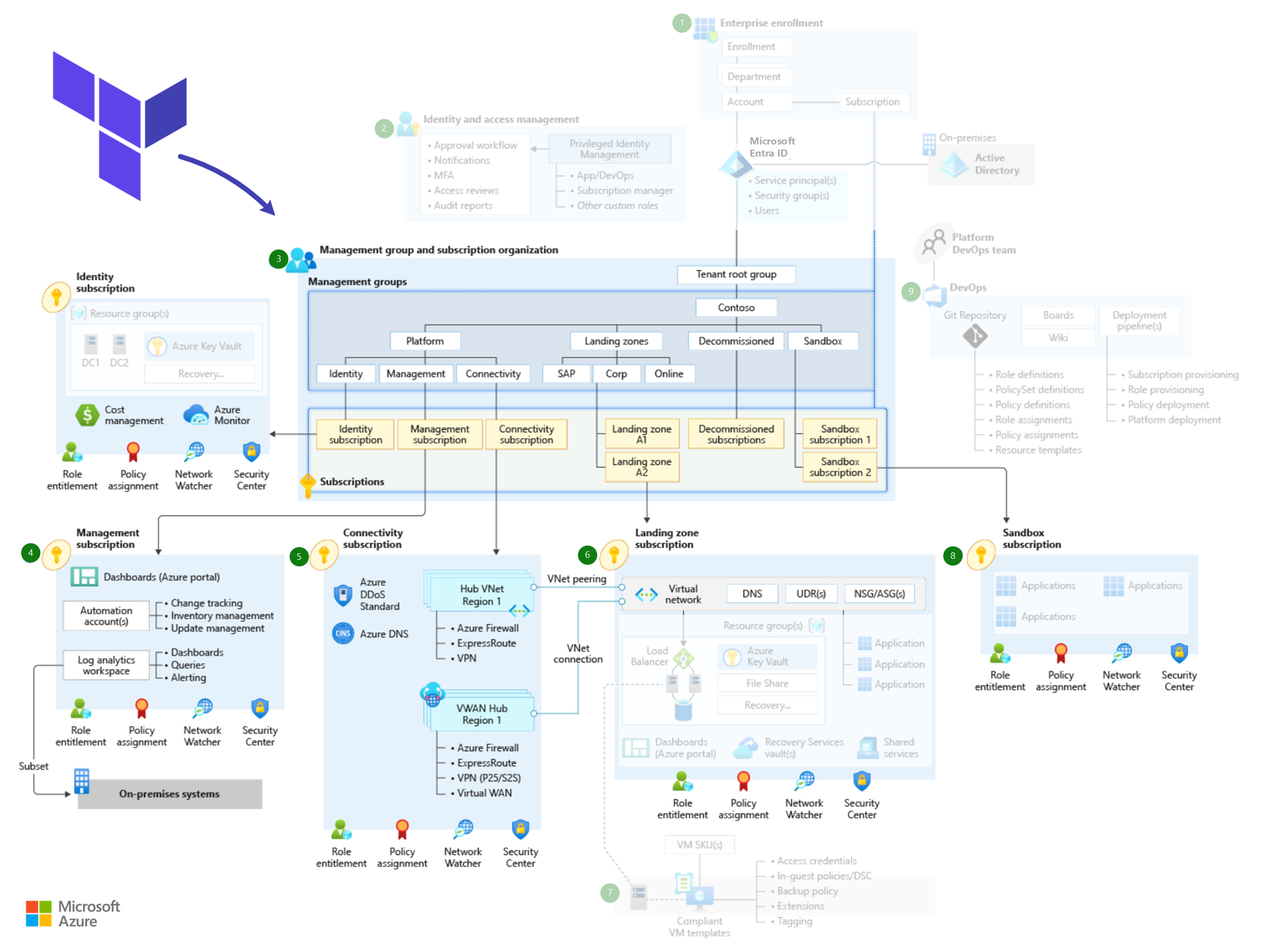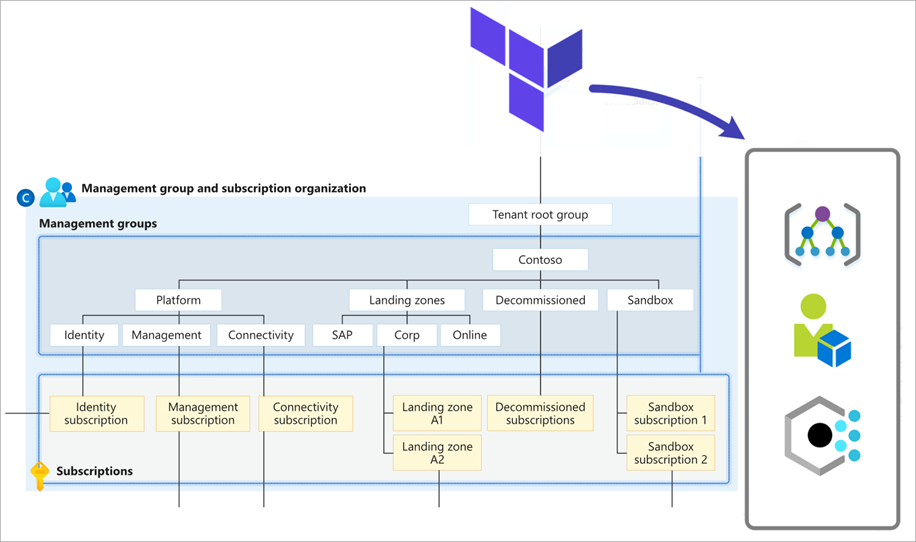Azure landing zones - Terraform module design considerations
This article discusses important areas to consider when using the Azure landing zones Terraform module. The module provides an opinionated approach to deploy and operate an Azure platform based on the Azure landing zone conceptual architecture as detailed in the Cloud Adoption Framework (CAF).
Terraform is an open-source Infrastructure as Code (IaC) tool, created by HashiCorp, that uses declarative syntax to deploy infrastructure resources. It is extensible, has cross-platform support and enables immutable infrastructure through state tracking.
Important
The module is available on the Terraform Registry: Azure landing zones Terraform module. You can use it as a starting point and configure it as per your needs.
Note
There are implementations for several deployment technologies, including portal-based, ARM templates and Terraform modules. The choice of deployment technology should not influence the resulting Azure landing zones deployment.
ALZ Terraform Accelerator
To quickly get started deploying ALZ with Terraform you can leverage the ALZ Terraform Accelerator that is designed to be used as a template. This repository provides a supporting implementation of the Azure Landing Zones Terraform module, with Azure DevOps pipelines and GitHub actions workflows.
The ALZ Terraform Accelerator follows a 3 phase approach:
- Prerequisites: Instructions to configure credentials and subscriptions.
- Bootstrap: Run the PowerShell script to generate the continuous delivery environment.
- Run: Update the module (if needed) to suit the needs of your organization and deploy via continuous delivery.
Start with user guide with a step by step to get your Azure Landing Zone environment up and running.
Design
The architecture takes advantage of the configurable nature of Terraform and is composed of a primary orchestration module. This module encapsulates multiple capabilities of the Azure landing zones conceptual architecture. You can deploy each capability individually or in part. For example, you can deploy just a hub network, or just the Azure DDoS Protection, or just the DNS resources. When doing so, you need to take into account that the capabilities have dependencies.
The architecture utilizes an orchestrator approach to simplify the deployment experience. You might prefer to implement each capability using one or more dedicated module instances where each is dedicated to a specific part of the architecture. This is all possible with the correct configuration
Modules
A core concept in Terraform is the use of modules. Modules enable you to organize deployments into logical groupings. With modules, you improve the readability of your Terraform files by encapsulating complex details of your deployment. You can also easily reuse modules for different deployments.
The ability to re-use modules offers a real benefit when defining and deploying landing zones. It enables repeatable, consistent environments in code while reducing the effort required to deploy at scale.
The Terraform implementation of Azure landing zones is delivered using a single module that acts as an orchestration layer. The orchestration layer allows you to select which resources are deployed and managed using the module. The module can be used multiple times in the same environment to deploy resources independently from each other. This can be useful in organizations where different teams are responsible for the different capabilities, or collections of sub-resources.
Layers and staging
The implementation focuses on the central resource hierarchy of the Azure landing zone conceptual architecture. The design is centered around the following capabilities:
- Core resources
- Management resources
- Connectivity resources
- Identity resources
The module groups resources into these capabilities as they are intended to be deployed together. These groups form logical stages of the implementation.
You control the deployment of each of these capabilities by using feature flags. A benefit of this approach is the ability to add to your environment incrementally over time. For example, you can start with a small number of capabilities. You can add the remaining capabilities at a later stage when you're ready.
Core resources
The core resources capability of the module aligns to the resource organization design area of the Cloud Adoption Framework. It deploys the foundational resources of the conceptual architecture for Azure landing zones.
Archetypes
An important concept within the core resources capability is the inclusion of archetypes.
Archetypes provide a reusable, code-based approach to defining which policy definitions, policy set definitions, policy assignments, role definitions and role assignments must be applied at a given scope. In the Terraform implementation, these decisions are encapsulated as Archetype Definitions.
To create a landing zone, management groups are associated with an archetype definition. In the below example for a corp landing zone, the archetype_config has a pointer to the "es_corp" archetype definition. That definition contains all the policy and role configurations which will be added to this management group.
es_corp_landing_zones = {
"contoso-corp" = {
display_name = "Corp"
parent_management_group_id = "contoso-landing-zones"
subscription_ids = []
archetype_config = {
archetype_id ="es_corp"
parameters = {}
access_control = {}
}
}
When the built-in archetypes don't align to your requirements, the module provides options to either create new archetypes or make changes to existing.
Management resources
The management resources capability of the module aligns to the management design area of the Cloud Adoption Framework. This capability provides the option to deploy management and monitoring resources to the management platform landing zone.
Connectivity resources
The connectivity resources capability of the module provides the option to deploy the network topology and connectivity of the conceptual architecture for Azure landing zones.
Identity resources
The identity resources capability of the module aligns to the Azure identity and access management design area of the Cloud Adoption Framework. This capability provides the option to configure policies on the Identity platform landing zone.
Note
No resources are deployed with this capability. When the deploy_identity_resources variable is set to true, Azure Policy assignments are configured that protect resources in the identity platform landing zone subscription.
Module descriptions
This section provides a high-level overview of the resources deployed by this module.
| Layer | Resource Type(s) | Description | Useful Links |
|---|---|---|---|
| Core | Management Groups | Management groups are the highest level resources in an Azure tenant. Management groups allow you to more easily manage your resources. You can apply policy at the management group level and lower level resources will inherit that policy. Specifically, you can apply the following items at the management group level that will be inherited by subscriptions under the management group:
|
|
| Core | Policy definitions, policy assignments, and policy set definitions | DeployIfNotExists (DINE) or Modify policies help ensure the subscriptions and resources that make up landing zones are compliant. Policies are assigned to management groups through policy assignments. The policies ease the burden of management of landing zones. Policy set definitions group sets of policies together. Not all customers are able to use DINE or Modify policies. If that is the case for you, CAF guidance on custom policies provides guidance. |
|
| Core | Role definitions and role assignments | Role-based access control (RBAC) simplifies the management of user rights within a system. Instead of managing the rights of individuals, you determine the rights required for different roles in your system. Azure RBAC has several built-in roles. Custom role definitions allow you to create custom roles for your environment. Identity and access management (IAM) is the key security boundary in cloud computing. Azure RBAC allows you to perform role assignments of built-in roles or custom role definitions to Service Principals, Managed Identities or security groups across management groups and subscriptions. |
|
| Management | Azure Monitor, Azure Automation, and Microsoft Sentinel | Azure Monitor, Azure Automation and Microsoft Sentinel allow you to monitor and manage your infrastructure and workloads. Azure Monitor is a solution that allows you to collect, analyze and act on telemetry from your environment. Microsoft Sentinel is a cloud-native security information and event management (SIEM). It allows you to:
Azure Automation is a cloud-based automation system. It includes:
|
|
| Connectivity | Core networking resource types listed here | Network topology is a key consideration in Azure landing zone deployments. CAF focuses on two core networking approaches:
|
|
| Connectivity | Azure DDoS Protection | Azure landing zone guidance recommends enabling Azure DDoS Network Protection. This service offers turnkey protection against DDoS attacks. | |
| Connectivity | DNS Zones, Private DNS Zones, and Private DNS Zone Virtual Network Link | Private DNS zones can be deployed to support the use of private endpoints. A private endpoint is a NIC that is assigned a private IP address from your virtual network. You can use the private IP address to securely communicate to services that supports Azure Private Link. Private DNS zones can be configured to resolve the fully qualified domain name (FQDN) of the service to the private endpoint private IP address. |
Using the Terraform module
Deploying core resources
By default, the module will deploy the following hierarchy, which is the core set of landing zone management groups:
- Root
- Platform
- Identity
- Management
- Connectivity
- Landing zones
- Decommissioned
- Sandbox
- Platform
The SAP, Corp and Online landing zone management groups don't apply to everyone so they aren't deployed by default. The following are ways to deploy these:
- For demo purposes, you can set the
deploy_demo_landing_zonesvariable to true that will deploy SAP, Corp and Online landing zones - For production purposes, you can turn on the management groups you want by setting the following variables to true:
deploy_corp_landing_zonesdeploy_online_landing_zonesdeploy_sap_landing_zones
- You can deploy your own custom landing zone management groups by creating a custom landing zone definition
Deploying management resources
To deploy the management resources, the deploy_management_resources variable must be set to true and the subscription_id_management variable must be set to the ID of the management subscription where the resources are to be deployed.
deploy_management_resources = true
subscription_id_management = <management subscription id>
Deploying connectivity resources
Deploy Connectivity Resources provides guidance on how to deploy these topologies.
Deploying identity resources
To deploy the identity capability, the deploy_identity_resources variable must be set to true and the subscription_id_identity variable must be set to the ID of the identity subscription where the policies are to be configured.
deploy_identity_resources = true
subscription_id_identity = <identity subscription id>
Customizing the Terraform implementation
The Azure landing zone implementations provided as part of the Cloud Adoption Framework suit a wide variety of requirements and use cases. However, there are often scenarios where customization is required to meet specific business needs.
Tip
See Tailor the Azure landing zone architecture to meet requirements for further information.
The Azure landing zones Terraform module can be used as the basis of your customized deployment. It provides you a way to accelerate your implementation by removing the need to start from scratch because of a specific required change that rules a ready-made option out.
 Information on customizing the modules is available in the GitHub repo wiki GitHub: Azure landing zones Terraform module - Wiki. You can use it as a starting point and configure it as per your needs.
Information on customizing the modules is available in the GitHub repo wiki GitHub: Azure landing zones Terraform module - Wiki. You can use it as a starting point and configure it as per your needs.

